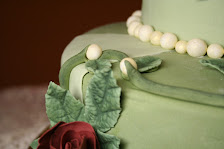Days 68 and 69: A Wrinkle in Time.
It’s been tricky finding words for this next cake. But I suppose that’s true of any cake whose execution requires the use of a pasta roller. The Chocolate Ribbon Cake, as it’s called, is a chocolate lover’s dream… layers of chocolate cake filled and iced with chocolate mousse, wrapped in a layer of chocolate plastique, and decorated on top with curly ribbons in the same medium. Cranking out cakes and mousses these days is pretty simple; literally cranking out paper thin sheets of chocolate is another matter.
Chocolate plastique is made by adding a small amount of corn syrup to melted chocolate. Once this re-hardens, you knead it until it is smooth and pliable; the texture reminds me of the probably toxic modeling clay that I used to play with more years ago than I care to count. Using it to sculpt things like baroque flowers is a treat we’re saving for down the road a bit. For the chocolate ribbon cake, the grandest assignment on the proverbial chalkboard was to make rectangles. Lots and lots of rectangles. The first of these, of course, was a very long rectangle, a band with which we covered the sides of the cake. Obviously you don’t want the people eating this cake to get such big globs of this chocolate material in their mouth that it would leave them singing Everything I See Looks Like a Ribbon Cake To Me, if you catch my drift. It’s a little like… well, modeling clay, as I said. To avoid just this predicament, we rolled the plastique to incredible thinness using the pasta roller. Now, I wasn’t there when the ingredients for our plastique were measured, but it seemed pretty straightforward. I don’t know what went wrong exactly, but my team’s came out dramatically different than everyone else’s. It was extremely melty, if that’s a word, and it had a peculiar interest in wrapping itself around the pasta machine’s rollers rather than gracefully passing through them. When chocolate plastique does this, all there is for it is a light dusting of cocoa powder, but if you can’t imagine how dangerous that is, go dip your finger into some cocoa powder and lick it off. Gingerly dusting our glob with two-molecule-thick layers of cocoa powder, we coaxed it through the rollers, gradually narrowing them, re-dusting at the first signs of trouble, until it was thin enough to be applied to the cake (not to mention palatable). We wrapped our band around the sides of the cake as smoothly as possible, sealing it at the seam.
The balance of rectangles were much smaller, about two inches by three. We made dozens of these after rolling out the remainder of our plastique. Then, as if we hadn’t teased it enough, we pleated up each small piece and laid it on top of the cake, overlapping each with the next. As unhinged as I had become, beset by roller-woes, I was forced to admit to myself after completing half the top that the cake was taking on a very elegant aspect. In quite a contrast to the buttercream and ganache we’ve been covering our cakes with so far, its plastique covering lent this cake a very fabric-like appearance. (Surely this is a hint of what’s to come when we undertake our segment on wedding cakes in the final quarter.) Continuing around the entire circumference in this manner, and then again in smaller circles, we carried on until the entire surface of the cake was safely tucked away. Some simple decorations on the top, including our introduction to gold paint, and the cake was ready for display in any bakery’s window.
I was pleased with the way my cake looked, and, clearly, excited about how it would taste. Later, however, an odd thing happened. As we traveled home, I gave the cake to a random woman who came upon my classmates and me on the subway. There can be only one of two explanations for this. Either I had reached the point where the Voice of Pastry is calling out to me less forcefully, or I had simply had too much sugar during class. I certainly hope that the latter is the case.
The former is too depressing.
Thursday, May 10, 2007
Subscribe to:
Post Comments (Atom)































































No comments:
Post a Comment